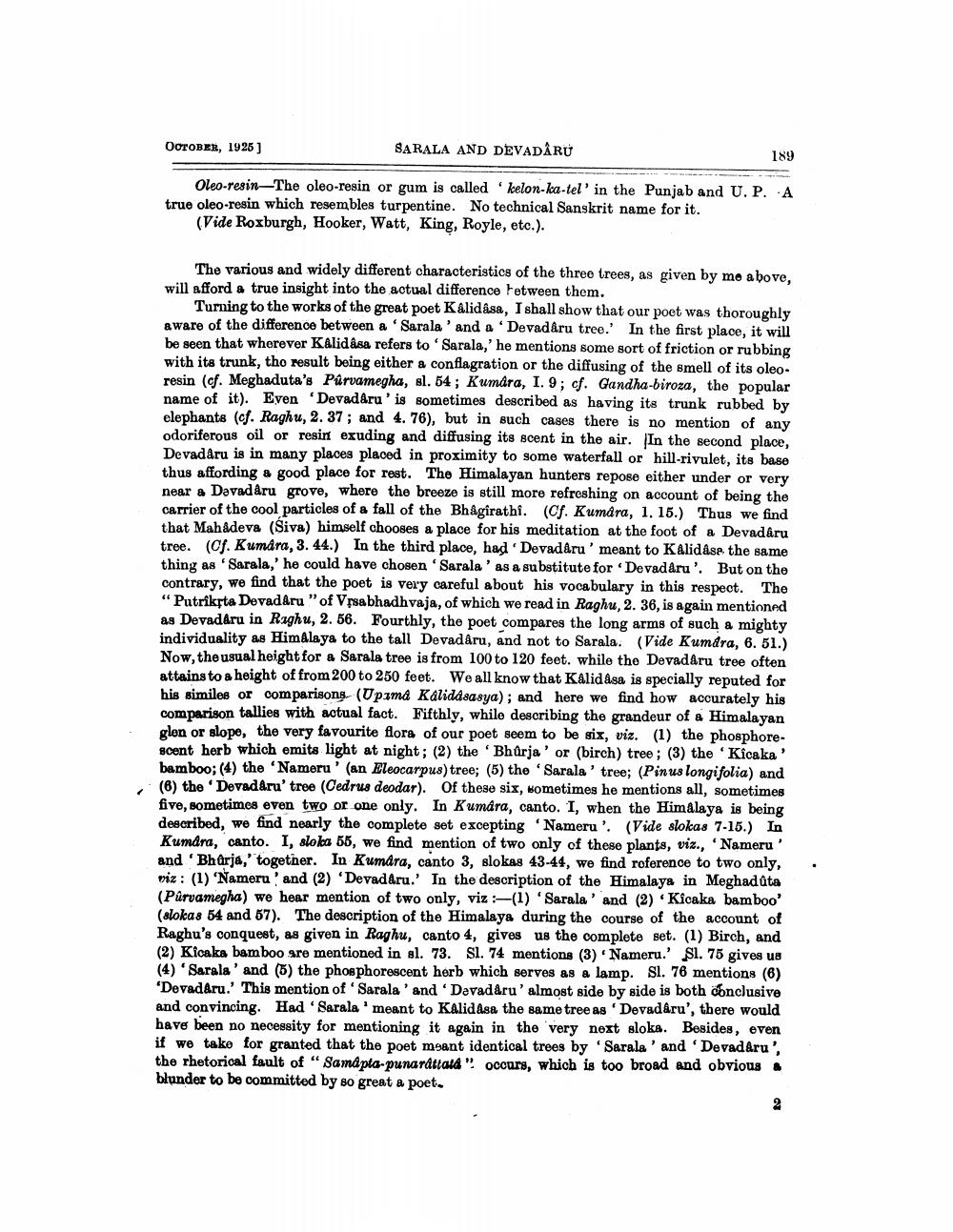________________
OCTOBER, 1925]
SARALA AND DEVADARU
Oleo-resin-The oleo-resin or gum is called kelon-ka-tel' in the Punjab and U. P. A true oleo-resin which resembles turpentine. No technical Sanskrit name for it.
(Vide Roxburgh, Hooker, Watt, King, Royle, etc.).
189
The various and widely different characteristics of the three trees, as given by me above, will afford a true insight into the actual difference between them.
Turning to the works of the great poet Kalidasa, I shall show that our poet was thoroughly aware of the difference between a 'Sarala' and a Devadâru tree.' In the first place, it will be seen that wherever Kalidasa refers to 'Sarala,' he mentions some sort of friction or rubbing with its trunk, the result being either a conflagration or the diffusing of the smell of its oleoresin (cf. Meghaduta's Pûrvamegha, sl. 54; Kumara, I. 9; cf. Gandha-biroza, the popular name of it). Even 'Devadaru' is sometimes described as having its trunk rubbed by elephants (cf. Raghu, 2. 37; and 4. 76), but in such cases there is no mention of any odoriferous oil or resin exuding and diffusing its scent in the air. In the second place, Devadâru is in many places placed in proximity to some waterfall or hill-rivulet, its base thus affording a good place for rest. The Himalayan hunters repose either under or very near a Devadaru grove, where the breeze is still more refreshing on account of being the carrier of the cool particles of a fall of the Bhagirathi. (Cf. Kumara, 1. 15.) Thus we find that Mahadeva (Siva) himself chooses a place for his meditation at the foot of a Devadâru tree. (Cf. Kumara, 3. 44.) In the third place, had' Devadaru' meant to Kalidase the same thing as 'Sarala,' he could have chosen 'Sarala' as a substitute for 'Devadâru'. But on the contrary, we find that the poet is very careful about his vocabulary in this respect. The "Putrikṛta Devadaru "of Vrsabhadhvaja, of which we read in Raghu, 2. 36, is again mentioned as Devadaru in Raghu, 2. 56. Fourthly, the poet compares the long arms of such a mighty individuality as Himalaya to the tall Devadâru, and not to Sarala. (Vide Kumára, 6. 51.) Now, the usual height for a Sarala tree is from 100 to 120 feet. while the Devadâru tree often attains to a height of from 200 to 250 feet. We all know that Kalidasa is specially reputed for his similes or comparisons (Upama Kálidasasya); and here we find how accurately his comparison tallies with actual fact. Fifthly, while describing the grandeur of a Himalayan glen or slope, the very favourite flora of our poet seem to be six, viz. (1) the phosphorescent herb which emits light at night; (2) the 'Bhûrja' or (birch) tree; (3) the 'Kicaka bamboo; (4) the 'Nameru' (an Eleocarpus) tree; (5) the 'Sarala' tree; (Pinus longifolia) and (6) the 'Devadaru' tree (Cedrus deodar). Of these six, sometimes he mentions all, sometimes five, sometimes even two or one only. In Kumára, canto. I, when the Himalaya is being described, we find nearly the complete set excepting 'Nameru'. (Vide slokas 7-15.) In Kumara, canto. I, sloka 55, we find mention of two only of these plants, viz., Nameru' and Bhurja, together. In Kumara, canto 3, slokas 43-44, we find roference to two only, viz: (1) 'Nameru and (2) 'Devadaru.' In the description of the Himalaya in Meghadûta (Pûrvamegha) we hear mention of two only, viz:-(1) 'Sarala' and (2) Kicaka bamboo' (slokas 54 and 57). The description of the Himalaya during the course of the account of Raghu's conquest, as given in Raghu, canto 4, gives us the complete set. (1) Birch, and (2) Kicaka bamboo are mentioned in sl. 73. Sl. 74 mentions (3) Nameru.' Sl. 75 gives us (4) Sarala' and (5) the phosphorescent herb which serves as a lamp. Sl. 76 mentions (6) 'Devadaru.' This mention of 'Sarala' and 'Devadaru' almost side by side is both conclusive and convincing. Had 'Sarala' meant to Kalidasa the same tree as 'Devadâru', there would have been no necessity for mentioning it again in the very next sloka. Besides, even if we take for granted that the poet meant identical trees by Sarala' and 'Devadaru', the rhetorical fault of "Samapta-punaráttald" occurs, which is too broad and obvious a blunder to be committed by so great a poet.
2




